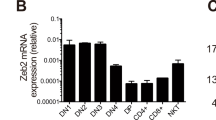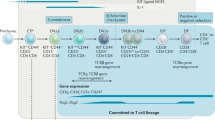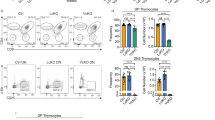Abstract
THE zinc-finger transcription factor GATA-3 is expressed in haematopoietic cells and in the developing kidney and nervous system1–7. Within the haematopoietic lineages, expression of GATA-3 is restricted to thymocytes and T cells. Functionally important GATA-3 binding sites have been identified in multiple T-cell-specific genes1,6–8. Mice containing homozygous null mutations of the GATA-3 gene die on embryonic day 12, precluding a detailed assessment of the role of GATA-3 in haematopoietic development9. Here we have used murine embryonic stem (ES) cells containing homozygous mutations in the GATA-3 gene (GATA-3−/− ) in conjunction with the RAG-2−/− (ref. 10) and C57BL/6 complementation systems to study the role of GATA-3 in mammalian haematopoiesis. Our results show that GATA-3−/− ES cells can contribute to the development of the mature ery-throid, myelomonocytic and B-cell lineages, but fail to give rise to thymocytes or mature peripheral T cells. The differentiation of GATA-3−/−T cells is blocked at or before the earliest double-negative (CD4−/CD8−) stage of thymocyte development, such that the GATA-3−/− ES cells are unable to contribute measurably to the double-negative thymocyte population. These findings suggest that GATA-3 is an essential and specific regulator of early thymocyte development.
This is a preview of subscription content, access via your institution
Access options
Subscribe to this journal
Receive 51 print issues and online access
$199.00 per year
only $3.90 per issue
Buy this article
- Purchase on SpringerLink
- Instant access to full article PDF
Prices may be subject to local taxes which are calculated during checkout
Similar content being viewed by others
References
Ho, I.-C. et al. EMBO J. 10, 1187–1192 (1991).
Oosterwegel, M., Timmerman, J., Leiden, J. & Clevers, H. Dev. Immunol. 3, 1–11 (1992).
George, K. M. et al. Development 120, 2673–2686 (1994).
Labastie, M. C. et al. Genomics 21, 1–6 (1994).
Labastie, M. C., Catala, M., Gregoire, J. M. & Peault, B. Kidney Int. 47, 1597–1603 (1995).
Ko, L. J. et al. Mol. Cell. Biol. 5, 2778–2784 (1991).
Marine, J. & Winoto, A. Proc. Natl Acad. Sci. USA 88, 7284–7288 (1991).
Hambor, J. E., Mennone, J., Coon, M. E., Hanke, J. H. & Kavathas, P. Mol. Cell. Biol. 13, 7056–7070 (1993).
Pandolfi, P. et al. Nature Genet. 11, 40–44 (1995).
Chen, J., Lansford, R., Stewart, V., Young, F. & Alt, F. Proc. Natl Acad. Sci. USA 90, 4528–4532 (1993).
Shinkai, Y. et al. Cell 68, 855–867 (1992).
Godfrey, D. I., Kennedy, J., Mombaerts, P., Tonegawa, S. & Zlotnik, A. J. Immunol. 152, 4783–4792 (1994).
Padua, R. A., Bulfield, G. & Peters, J. Biochem. Genet. 16, 127–143 (1978).
Clevers, H. & Grosschedl, R. Immunol. Today 17, 336–343 (1996).
Leiden, J. M. Annu. Rev. Immunol. 11, 539–570 (1993).
Scott, E. W., Simon, M. C., Anastasi, J. & Singh, H. Science 265, 1573–1577 (1994).
Olson, M. et al. Immunity 3, 703–714 (1995).
Georgopoulos, K. et al. Cell 79, 143–156 (1994).
Okuda, T., van Deursen, J., Hiebert, S. W., Grosveld, G. & Downing, J. R. Cell 84, 321–330 (1996).
Shivdasani, R. A., Mayer, E. L. & Orkin, S. H. Nature 373, 432–434 (1995).
Tsai, F.-Y. et al. Nature 371, 221–226 (1994).
Mucenski, M. L. et al. Cell 65, 677–689 (1991).
Verbeek, S. et al. Nature 374, 70–74 (1995).
Bories, J.-C. et al. Nature 377, 635–638 (1995).
Muthusamy, N., Barton, K. & Leiden, J. M. Nature 377, 639–642 (1995).
Redondo, J., Hata, S., Brocklehurst, C. & Krangel, M. Science 247, 1225–1229 (1990).
Mombaerts, P. et al. Nature 360, 225–231 (1992).
Shinkai, Y. et al. Science 259, 822–825 (1993).
Alt, F. W. et al. Immunol. Today 13, 306–314 (1992).
Tybulewicz, V. L., Crawford, C. E. Jackson, P. K., Bronson, R. T. & Mulligan, R. C. Cell 65, 1153–1163 (1991).
Author information
Authors and Affiliations
Rights and permissions
About this article
Cite this article
Ting, CN., Olson, M., Barton, K. et al. Transcription factor GATA-3 is required for development of the T-cell lineage. Nature 384, 474–478 (1996). https://doi.org/10.1038/384474a0
Received:
Accepted:
Issue Date:
DOI: https://doi.org/10.1038/384474a0



